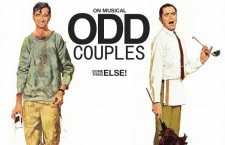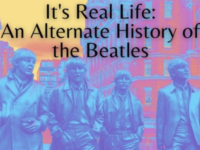So, I recently had some down time, much of which I spent watching rock ‘n’ roll movies. But it turned out taking on that task was much harder than just kicking back in front of the ol’ TV for a few weeks.
The problem is twofold. First; there are a whole lot of rock ‘n’ roll related movies out there. And second; there isn’t any consensus as to what exactly constitutes a rock ‘n’ roll movie. Is it a band documentary? How about a biopic? Or a story about a fictitious band? Or no band at all? Does a musical qualify, or is just having a rockin’ soundtrack good enough?
For better or worse, here are a few things I’ve seen – some recently, and some a while back; some I’ve viewed only once, and others many times over. I’m not sure what conclusions can be drawn here, so draw your own.
CONCERTS & DOCUMENTARIES: At the most basic level, concert films record what exactly went down at a particular time and place, so in that sense are very much grounded in reality. Woodstock (1970) or Led Zeppelin’s Celebration Day (2012) are examples of just running the camera and showing what happened.
Other films, however, seem to rely on a certain amount of staging, as Neil Young’s Rust Never Sleeps (1979) or Talking Heads’ Stop Making Sense (1984). I suppose it’s easy to take the position that Woodstock and Celebration Day were just as staged, but the effect is a lot less obvious. Or, maybe it’s simply that something fundamentally changes when transferring a live musical performance to its cinematic equivalent.
Then there are mostly straightforward documentaries like the oddly dry The Compleat Beatles (1982) or something more interesting like The Kids Are Alright (1979). The recent Echoes in the Canyon (2019) focuses specifically on the Laurel Canyon music scene in Los Angeles circa 1965-67. Accompanied by new performances by Jakob Dylan and assorted guests, it manages to be both a documentary and a concert film at the same time.
And finally let’s mention Dig! (2004), the Brian Jonestown Massacre vs. the Dandy Warhols documentary and Some Kind of Monster (2004), the Metallica film, which I recently rediscovered lurking about on Netflix. Neither was particularly enjoyable, although I did wonder if Brian Jonestown Massacre had been able to afford a band psychiatrist like Metallica, would they have made an album as vilified as St. Anger? And would that have been necessarily a good thing?
BIOPICS AND PSEUDO DOCS: Here’s where it get interesting: if the performances have been scripted to suit the arc of storytelling, with actors sometimes filling the roles instead of the actual music artists, is that necessarily any more or less accurate than a “real” documentary? For instance, so many people complained about Bohemian Rhapsody (2018) and what it got wrong when it came to who said this or that. Meanwhile, others made a point of raving over the Live Aid concert recreation and how parts of it were very close to the original. Maybe all of them would have been happier with an actual documentary about Queen or Freddie Mercury.
And who can forget A Hard Day’s Night (1964)? Is that really a movie about the Beatles or just “the Beatles” as people imagined them? You have to wonder how closely the myth intertwines with reality.
And then there’s Rolling Thunder Revue: A Bob Dylan Story by Martin Scorsese (2019). Reality or fantasy? Sharon Stone as a groupie? Kiss as inspiration for the greasepaint Dylan sported for most of this tour (even if Dylan’s fiddle player Scarlet Rivera apparently did date Gene Simmons for a while)? “If someone’s wearing a mask, he’s gonna tell you the truth,” says Dylan. Who, of course, says this on film without the benefit of his disguise – which makes you wonder if he’s even bothered to take it off since about 1965 or so. But it does make for a more interesting story.
FAKE BANDS: Speaking of stories, some of my favorite ones involve totally fictional bands and the trials and tribulations of being a rock star. These can be played for laughs like The Blues Brothers (1980) or This Is Spinal Tap (1984), or sometimes more dramatically like The Commitments (1991) or A Star Is Born (2018).
But some films confuse the issue. Take Purple Rain (1984): is it a work of fiction, or a thinly disguised autobiography of Prince? And what about Rock ‘n’ Roll High School (1979)? Is it supposed to be about the Ramones, or Riff Randal writing their next big hit, or Kate Rambeau splitting atoms and blowing up Vince Lombardi High?
There’s plenty of room for crossing over the line here, and that’s not just about the bands. For instance: Almost Famous (2000) might be about a fictional band called Stillwater and a young reporter named William Miller – unless it’s about a real band named Stillwater, or the Allman Brothers, or director/writer Cameron Crowe himself in his younger days. Former Rolling Stone editor Ben Fong-Torres is a real person, as was rock critic Lester Bangs, both of whom have actors playing them in the film.
Maybe these kinds of movies need to be very obviously fictional. In that way, maybe something like Eddie and the Cruisers (1983) makes better sense as a story if you’re not trying to figure out how it is that fictional ’60s Jersey singer/guitarist Eddie Wilson fronts a band that sounds like late-’70s Bruce Springsteen. And the anime series Beck Mongolian Chop Squad (2004) makes the separation even more complete, though the live action movie (released in 2010) isn’t quite as good as the source.
FICTION: And lastly, there’s a whole series of rock ‘n’ roll movies that run the spectrum from doing a good job of capturing the essence of rock sensibilities to having nothing to do with rock ‘n’ roll at all. Phantom of the Paradise (1974), Rocky Horror Picture Show (1975), Moulin Rouge (2001) and Across the Universe (2007) basically show that you can always sell a good musical. Meanwhile, all those things that should be subversive in a so-called School of Rock (2003) turn out to be a nothing more than a very mainstream lesson in “believing in yourself.” And Yesterday (2019), although having an interesting premise, is in the end just a rom-com set to Beatles’ music.
[SOMETHING ELSE! INTERVIEW: Beverly Paterson is joined by co-founding Foghat drummer Roger Earl for a discussion on sticking with the blues, and how they survived decades of change.]
But there are two films in particular that are often considered exceptional by those who know more about film than I do: American Graffiti (1973) and Dazed and Confused (1993). Both seem to capture the essence of American teen culture in different points in time (the early ’60s and the early ’70s, respectively), and the important part that rock music played in those times. It’s also interesting how each film ends: American Graffiti uses an onscreen epilogue to tell us of the alternately tragic and mundane fates of its four main characters, while Dazed and Confused simply shows the cast driving off to get Aerosmith tickets while Foghat’s “Slow Ride” plays over the fade out. Different times and different priorities, for sure.
To finish, let me cram in these two final films, which kind of didn’t fit anywhere else. There’s the Monkees’ Head (1968), a fake/real band doing an pseudo-autobiographical rant in a work of fiction about being manipulated into becoming a manufactured product, spliced with real concert footage and a plot that might be based on some of their experiences while making their television show and selling actual records by the millions. Like I said – you figure it out.
And (if you can find it), there’s also the indie short film Heavy Metal Parking Lot (1986), which is actual footage of some teenagers in a parking lot in Maryland waiting for a Judas Priest show. Since the Spinal Tap movie had already been released, you’d have thought everyone would’ve known better, or maybe not.
Though there’s not any concert footage or appearance by any band personnel whatsoever, it’s possibly the most honest rock ‘n’ roll documentary in history. Or maybe the only one: After all, rock ‘n’ roll was always about a particular moment, and maybe the only time it can be truly captured is that point in time when the world of fiction and non-fiction co-exist in that perfect balance of raw, unscripted anticipation and expectation.
- How David Bowie’s ‘The Next Day’ Stripped Away All of the Artifice - March 15, 2023
- Why Deep Purple’s ‘Who Do We Think We Are?’ Deserves Another Listen - January 11, 2023
- In Defense of the Often-Overlooked Mott the Hoople - November 10, 2022




